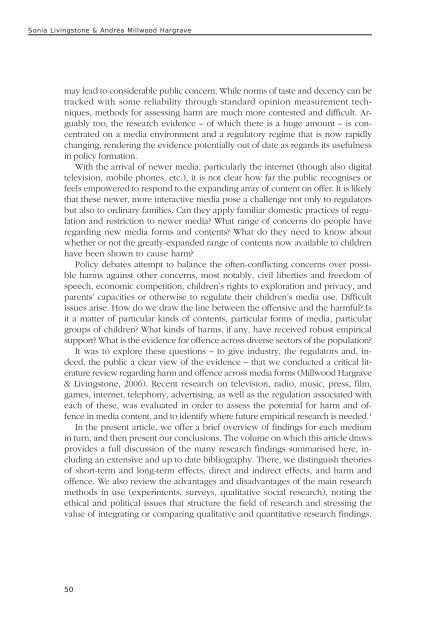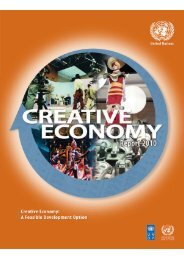In the Service of Young People? Studies and Reflections on Media ...
In the Service of Young People? Studies and Reflections on Media ...
In the Service of Young People? Studies and Reflections on Media ...
- No tags were found...
You also want an ePaper? Increase the reach of your titles
YUMPU automatically turns print PDFs into web optimized ePapers that Google loves.
S<strong>on</strong>ia Livingst<strong>on</strong>e & Andrea Millwood Hargravemay lead to c<strong>on</strong>siderable public c<strong>on</strong>cern. While norms <str<strong>on</strong>g>of</str<strong>on</strong>g> taste <str<strong>on</strong>g>and</str<strong>on</strong>g> decency can betracked with some reliability through st<str<strong>on</strong>g>and</str<strong>on</strong>g>ard opini<strong>on</strong> measurement techniques,methods for assessing harm are much more c<strong>on</strong>tested <str<strong>on</strong>g>and</str<strong>on</strong>g> difficult. Arguablytoo, <str<strong>on</strong>g>the</str<strong>on</strong>g> research evidence – <str<strong>on</strong>g>of</str<strong>on</strong>g> which <str<strong>on</strong>g>the</str<strong>on</strong>g>re is a huge amount – is c<strong>on</strong>centrated<strong>on</strong> a media envir<strong>on</strong>ment <str<strong>on</strong>g>and</str<strong>on</strong>g> a regulatory regime that is now rapidlychanging, rendering <str<strong>on</strong>g>the</str<strong>on</strong>g> evidence potentially out <str<strong>on</strong>g>of</str<strong>on</strong>g> date as regards its usefulnessin policy formati<strong>on</strong>.With <str<strong>on</strong>g>the</str<strong>on</strong>g> arrival <str<strong>on</strong>g>of</str<strong>on</strong>g> newer media, particularly <str<strong>on</strong>g>the</str<strong>on</strong>g> internet (though also digitaltelevisi<strong>on</strong>, mobile ph<strong>on</strong>es, etc.), it is not clear how far <str<strong>on</strong>g>the</str<strong>on</strong>g> public recognises orfeels empowered to resp<strong>on</strong>d to <str<strong>on</strong>g>the</str<strong>on</strong>g> exp<str<strong>on</strong>g>and</str<strong>on</strong>g>ing array <str<strong>on</strong>g>of</str<strong>on</strong>g> c<strong>on</strong>tent <strong>on</strong> <str<strong>on</strong>g>of</str<strong>on</strong>g>fer. It is likelythat <str<strong>on</strong>g>the</str<strong>on</strong>g>se newer, more interactive media pose a challenge not <strong>on</strong>ly to regulatorsbut also to ordinary families. Can <str<strong>on</strong>g>the</str<strong>on</strong>g>y apply familiar domestic practices <str<strong>on</strong>g>of</str<strong>on</strong>g> regulati<strong>on</strong><str<strong>on</strong>g>and</str<strong>on</strong>g> restricti<strong>on</strong> to newer media? What range <str<strong>on</strong>g>of</str<strong>on</strong>g> c<strong>on</strong>cerns do people haveregarding new media forms <str<strong>on</strong>g>and</str<strong>on</strong>g> c<strong>on</strong>tents? What do <str<strong>on</strong>g>the</str<strong>on</strong>g>y need to know aboutwhe<str<strong>on</strong>g>the</str<strong>on</strong>g>r or not <str<strong>on</strong>g>the</str<strong>on</strong>g> greatly-exp<str<strong>on</strong>g>and</str<strong>on</strong>g>ed range <str<strong>on</strong>g>of</str<strong>on</strong>g> c<strong>on</strong>tents now available to childrenhave been shown to cause harm?Policy debates attempt to balance <str<strong>on</strong>g>the</str<strong>on</strong>g> <str<strong>on</strong>g>of</str<strong>on</strong>g>ten-c<strong>on</strong>flicting c<strong>on</strong>cerns over possibleharms against o<str<strong>on</strong>g>the</str<strong>on</strong>g>r c<strong>on</strong>cerns, most notably, civil liberties <str<strong>on</strong>g>and</str<strong>on</strong>g> freedom <str<strong>on</strong>g>of</str<strong>on</strong>g>speech, ec<strong>on</strong>omic competiti<strong>on</strong>, children’s rights to explorati<strong>on</strong> <str<strong>on</strong>g>and</str<strong>on</strong>g> privacy, <str<strong>on</strong>g>and</str<strong>on</strong>g>parents’ capacities or o<str<strong>on</strong>g>the</str<strong>on</strong>g>rwise to regulate <str<strong>on</strong>g>the</str<strong>on</strong>g>ir children’s media use. Difficultissues arise. How do we draw <str<strong>on</strong>g>the</str<strong>on</strong>g> line between <str<strong>on</strong>g>the</str<strong>on</strong>g> <str<strong>on</strong>g>of</str<strong>on</strong>g>fensive <str<strong>on</strong>g>and</str<strong>on</strong>g> <str<strong>on</strong>g>the</str<strong>on</strong>g> harmful? Isit a matter <str<strong>on</strong>g>of</str<strong>on</strong>g> particular kinds <str<strong>on</strong>g>of</str<strong>on</strong>g> c<strong>on</strong>tents, particular forms <str<strong>on</strong>g>of</str<strong>on</strong>g> media, particulargroups <str<strong>on</strong>g>of</str<strong>on</strong>g> children? What kinds <str<strong>on</strong>g>of</str<strong>on</strong>g> harms, if any, have received robust empiricalsupport? What is <str<strong>on</strong>g>the</str<strong>on</strong>g> evidence for <str<strong>on</strong>g>of</str<strong>on</strong>g>fence across diverse sectors <str<strong>on</strong>g>of</str<strong>on</strong>g> <str<strong>on</strong>g>the</str<strong>on</strong>g> populati<strong>on</strong>?It was to explore <str<strong>on</strong>g>the</str<strong>on</strong>g>se questi<strong>on</strong>s – to give industry, <str<strong>on</strong>g>the</str<strong>on</strong>g> regulators <str<strong>on</strong>g>and</str<strong>on</strong>g>, indeed,<str<strong>on</strong>g>the</str<strong>on</strong>g> public a clear view <str<strong>on</strong>g>of</str<strong>on</strong>g> <str<strong>on</strong>g>the</str<strong>on</strong>g> evidence – that we c<strong>on</strong>ducted a critical literaturereview regarding harm <str<strong>on</strong>g>and</str<strong>on</strong>g> <str<strong>on</strong>g>of</str<strong>on</strong>g>fence across media forms (Millwood Hargrave& Livingst<strong>on</strong>e, 2006). Recent research <strong>on</strong> televisi<strong>on</strong>, radio, music, press, film,games, internet, teleph<strong>on</strong>y, advertising, as well as <str<strong>on</strong>g>the</str<strong>on</strong>g> regulati<strong>on</strong> associated wi<str<strong>on</strong>g>the</str<strong>on</strong>g>ach <str<strong>on</strong>g>of</str<strong>on</strong>g> <str<strong>on</strong>g>the</str<strong>on</strong>g>se, was evaluated in order to assess <str<strong>on</strong>g>the</str<strong>on</strong>g> potential for harm <str<strong>on</strong>g>and</str<strong>on</strong>g> <str<strong>on</strong>g>of</str<strong>on</strong>g>fencein media c<strong>on</strong>tent, <str<strong>on</strong>g>and</str<strong>on</strong>g> to identify where future empirical research is needed. 1<str<strong>on</strong>g>In</str<strong>on</strong>g> <str<strong>on</strong>g>the</str<strong>on</strong>g> present article, we <str<strong>on</strong>g>of</str<strong>on</strong>g>fer a brief overview <str<strong>on</strong>g>of</str<strong>on</strong>g> findings for each mediumin turn, <str<strong>on</strong>g>and</str<strong>on</strong>g> <str<strong>on</strong>g>the</str<strong>on</strong>g>n present our c<strong>on</strong>clusi<strong>on</strong>s. The volume <strong>on</strong> which this article drawsprovides a full discussi<strong>on</strong> <str<strong>on</strong>g>of</str<strong>on</strong>g> <str<strong>on</strong>g>the</str<strong>on</strong>g> many research findings summarised here, includingan extensive <str<strong>on</strong>g>and</str<strong>on</strong>g> up to date bibliography. There, we distinguish <str<strong>on</strong>g>the</str<strong>on</strong>g>ories<str<strong>on</strong>g>of</str<strong>on</strong>g> short-term <str<strong>on</strong>g>and</str<strong>on</strong>g> l<strong>on</strong>g-term effects, direct <str<strong>on</strong>g>and</str<strong>on</strong>g> indirect effects, <str<strong>on</strong>g>and</str<strong>on</strong>g> harm <str<strong>on</strong>g>and</str<strong>on</strong>g><str<strong>on</strong>g>of</str<strong>on</strong>g>fence. We also review <str<strong>on</strong>g>the</str<strong>on</strong>g> advantages <str<strong>on</strong>g>and</str<strong>on</strong>g> disadvantages <str<strong>on</strong>g>of</str<strong>on</strong>g> <str<strong>on</strong>g>the</str<strong>on</strong>g> main researchmethods in use (experiments, surveys, qualitative social research), noting <str<strong>on</strong>g>the</str<strong>on</strong>g>ethical <str<strong>on</strong>g>and</str<strong>on</strong>g> political issues that structure <str<strong>on</strong>g>the</str<strong>on</strong>g> field <str<strong>on</strong>g>of</str<strong>on</strong>g> research <str<strong>on</strong>g>and</str<strong>on</strong>g> stressing <str<strong>on</strong>g>the</str<strong>on</strong>g>value <str<strong>on</strong>g>of</str<strong>on</strong>g> integrating or comparing qualitative <str<strong>on</strong>g>and</str<strong>on</strong>g> quantitative research findings.50
















